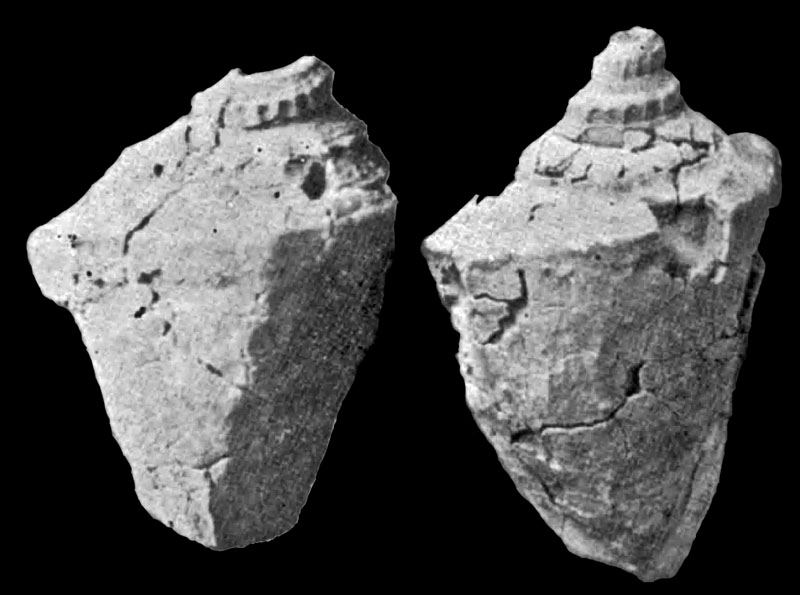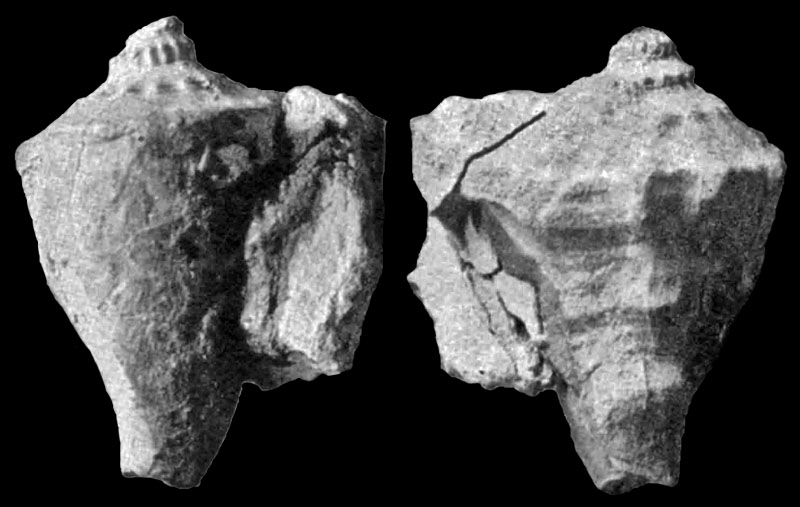|
edit SideBar
|
Species / Strombus Mekranicus
- Strombus mekranicus Vredenburg, 1925
Original Description of Strombus mekranicus by Vredenburg, 1925, p. 315:
- " Medium-size with extraconic spire equal to one-quarter of the total height, and corrugate-conical body-whorl with widely expanded outer lip. The protoconch, which is missing, is followed by six spire-whorls. The earlier spire-whorls are divided into two sections by a very pronounced angulation. Posteriorly to the angulation there is a broad, feebly sloping, flat or slightly excavate surface, carrying, at rather wide intervals, some very fine, raised, spiral threads. The anterior section of the whorls is vertical or even anteriorly sloping inward and is decorated with numerous, sharp, vertical costae or flutings, with somewhat spinose posterior terminations. They are crossed at intervals by a few inconspicuous, spiral threads. The number of costae on each of the whorls is from eighteen to twenty.This anterior, vertical division of the whorls becomes shorter in each succeeding spire-whorl as, with increasing growth, the suture creeps nearer to the angulation and finally corresponds with it. Consequently the two last spire-whorls and the posterior part of the body-whorl constitute an uninterrupted, gently sloping surface in which there is nothing to indicate the existence of costae save the waviness of the sutures. When the costae finally re-appear on the body-whorl they have assumed the appearance of short, broad spines, much fewer in number than on the spire-whorls. This disposition gives a curiously heteromorphous appearance to the spire which thus consists of a broad, very flatly conical, surface encircled by the few spines of the body-whorl, in the middle of which rises the steep, scalariform and fluted, steeple-like protrusion constituted by the earlier whorls. The large body-whorl, equal to nearly five-sixths of the total height, has a gibbous, elongate-conical base anteriorly terminated by a somewhat twisted rostration. On. the body-whorl the posterior angulation becomes deflected outward and backward to form the expanded angle of the wing-like outer lip. Anteriorly to the angulation and its coarse spines, the base contracts conically, but with a very irregular corrugated outline due to the presence of two swellings with obscure, blunt, broad, boss-like knobs. Feebly raised, wide-spaced, thin, spiral threads cover the base wherever not obscured by the great, callous spread from the columellar lip. The aperture is tall, elongate. The columella is smooth, oblique, feebly convex, anteriorly deflected near its extremity in accordance with the trend of the anterior rostration. The columellar lip is thin, widely spreading, with indistinct border. The incompletely preserved outer lip, carrying posteriorly a wing-shaped expansion, is oblique and probably convex."
Locus typicus: North of Talar Gorge, on the road from Kej to Gwadar, base of the sandstones constituting the Talar Mountains, North Western India
Stratum typicum: Mekran Beds, Miocene
Strombus mekranicus Vredenburg, 1925, pl. 3, fig. 13, 14
Strombus mekranicus Vredenburg, 1925, pl. 4, fig. 1 a, b
Comment:
References
- Vredenburg E 1925 Description of Mollusca from the Post-Eocene Tertiary formation of north western India: Cephalopoda, Opisthobranchiata, Siphonostomata, Gastropoda; Mem. Geol. Surv. India 50, 1-351, pls. 1-13.
|


